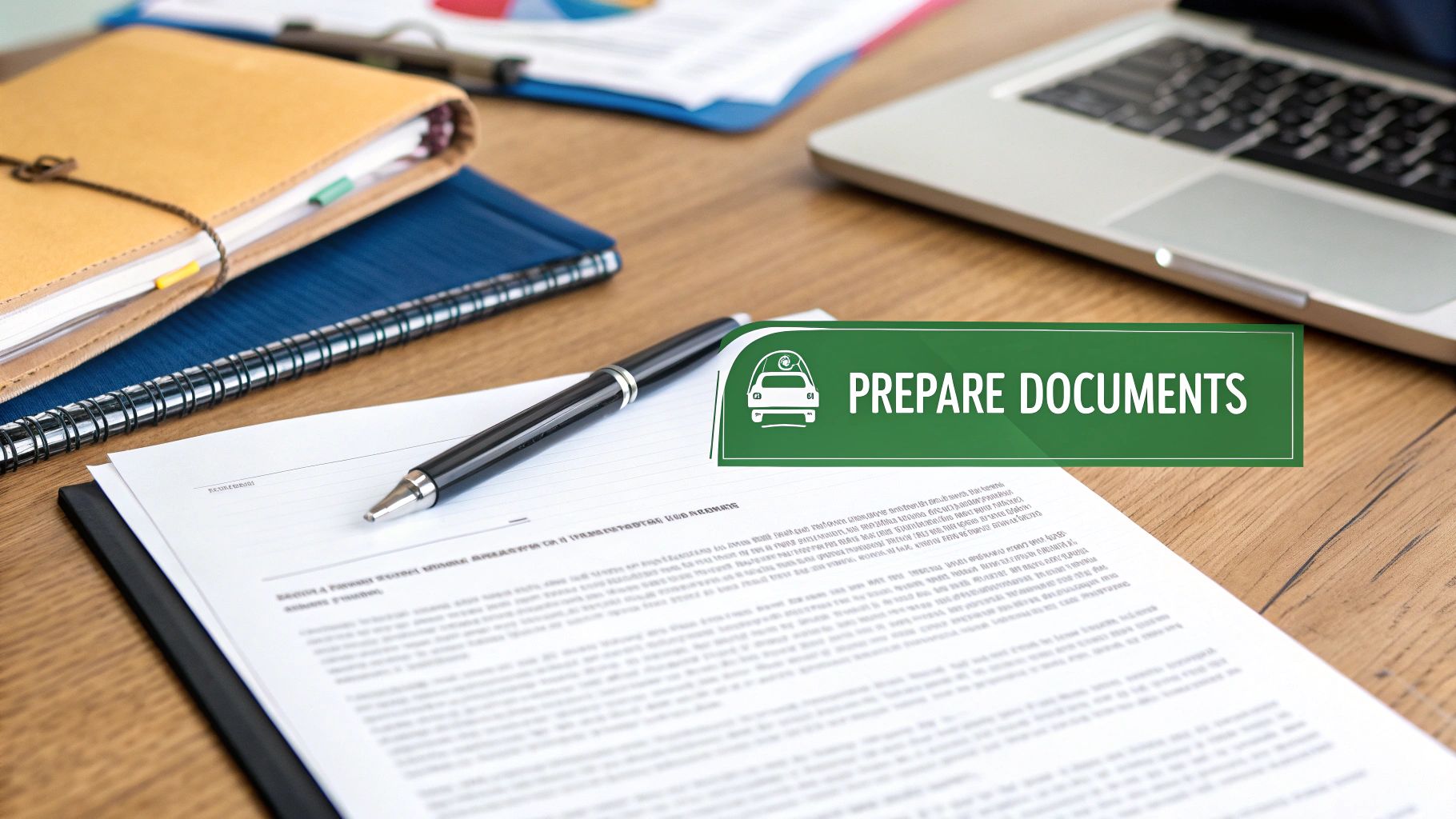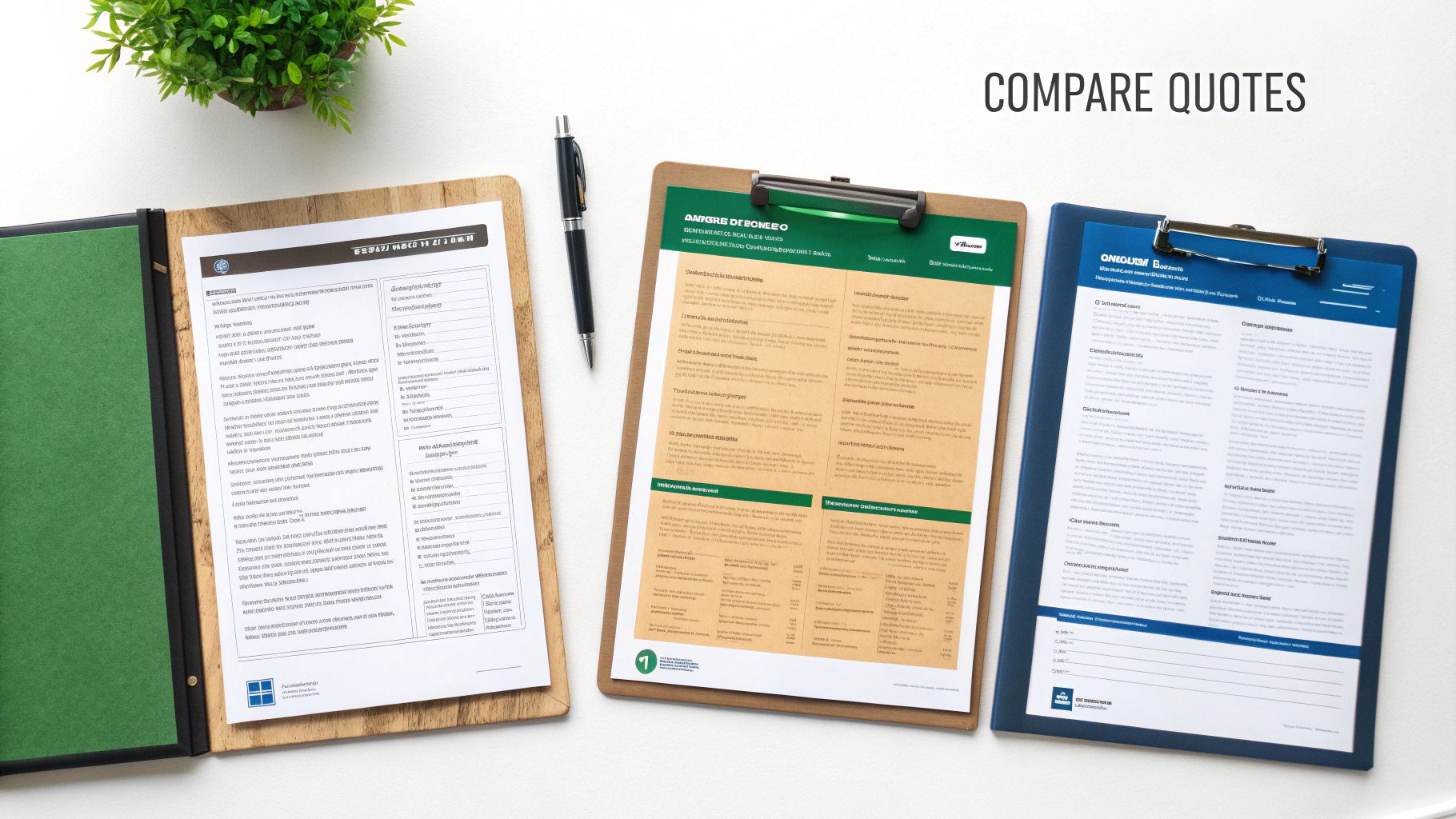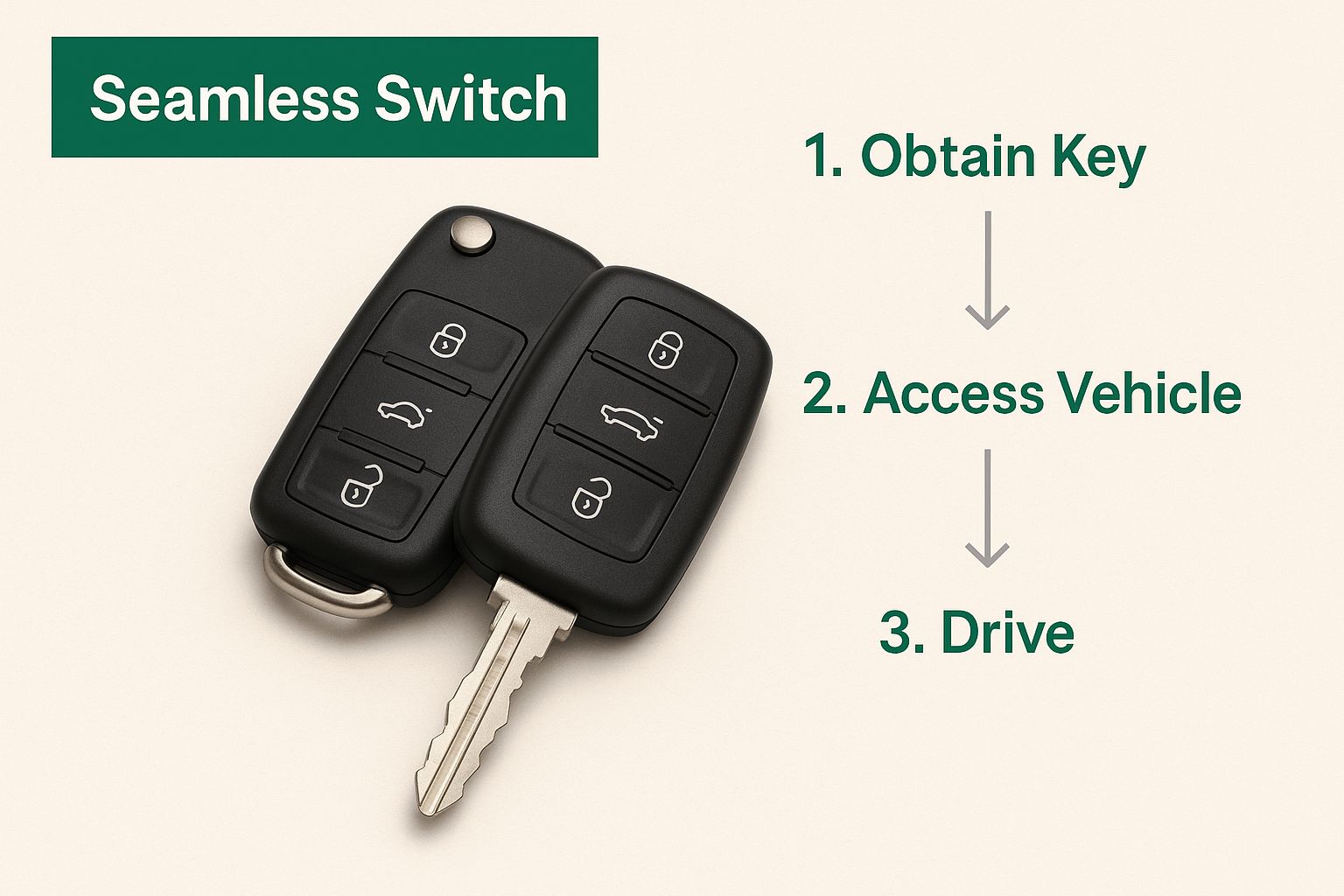It's easy to let your car insurance renew automatically every year. It’s one less thing to think about, right? The problem is, that loyalty often comes at a cost, and you could be seriously overpaying for your coverage.
The best time to shop for a new policy isn't just when your premium goes up. It's when your life changes. These moments are the perfect catalyst to reassess your needs and see if you can get a better deal elsewhere.
Knowing When It's Time for a New Policy
Most people don't think about changing their car insurance until they get that dreaded renewal notice with a shocking price hike. That's certainly a good reason to start shopping, but if you wait for your insurer to raise your rates, you’ve likely already missed out on potential savings.
A much smarter strategy is to get ahead of the game. Being proactive and comparing quotes after a major life event can put real money back in your pocket.
Major Life Events That Trigger a Rate Review
Certain milestones completely change how insurers see you from a risk perspective. If you’ve recently gone through any of these, it’s absolutely time to get some fresh quotes.
- You Moved to a New Zip Code: Where you live matters—a lot. Insurers set rates based on local statistics for things like accidents, theft, and traffic density. Moving to a zip code with lower risk could mean an instant drop in your premium.
- Your Credit Score Improved: This is a big one that most people miss. Insurers often use a credit-based insurance score to price your policy. If you've worked hard to improve your credit, you've earned a lower rate, but your current company probably won't adjust it unless you ask them to… or you switch to one that will.
- You Added a Teen Driver: Nothing sends your premium skyrocketing like adding a newly licensed teenager to your policy. Insurers all calculate this risk differently, so the company that gave you a great rate as a solo driver might be one of the most expensive for a family plan.
- You Bought a Home: If you just became a homeowner, congratulations! You also just unlocked one of the biggest insurance discounts available. Bundling your auto and home policies can save you up to 25%, but you can't get that deal from an auto-only provider.
Recognizing these triggers turns the annual insurance policy renewal process from a passive event into an active opportunity to optimize your finances and ensure your coverage matches your life. Exploring general car ownership insights can also highlight changes, like a new vehicle purchase, that warrant an insurance review.
Getting Your Documents Ready for Accurate Quotes
Before you start hunting for quotes, a little prep work will save you a ton of hassle. Having all your information in one place makes the whole process faster and, more importantly, ensures the quotes you get are the real deal—not just ballpark estimates.
Think of your current policy's declarations page as your cheat sheet. This one page has everything you need: your coverage limits, deductibles, and any add-ons. It's the key to making a true apples-to-apples comparison between your old policy and a potential new one.
The Essential Info You'll Need
To get a firm price when you change car insurance, you'll need to provide some specific details for every driver and vehicle you want to cover. Insurers rely on this data to calculate your risk and give you a solid number.
Grab these things before you begin:
- Driver's License Numbers: For everyone who will be on the policy.
- Vehicle Identification Numbers (VINs): For each car. You can usually find this on your current insurance card, your vehicle registration, or etched on the driver's side of the dashboard.
- Annual Mileage Estimates: Just a good-faith guess of how many miles each car is driven in a year.
- Driving History: Be prepared to mention any accidents or traffic violations within the last five years.
Being upfront about your driving history is a must. It’s also a good idea to ask your current insurer for a claims history document, often called a loss run report. If you're curious, you can learn more about what is a loss run report and see why it’s so valuable.
This simple step helps you sidestep any nasty surprises, like a quote that suddenly jumps up right before you buy because of a forgotten ticket.
The vehicle insurance market is booming—projected to hit USD 1,796.61 billion by 2034—and insurers are using tech to verify details faster than ever. Giving them accurate info from the get-go puts you in the driver's seat. See more vehicle insurance market trends on precedenceresearch.com.
Comparing Insurance Quotes Beyond the Price Tag
Alright, you've gathered a few quotes. Now the real work begins. It’s tempting to just grab the cheapest option and call it a day, but that's a classic mistake that can leave you financially exposed when you actually need your coverage.
The key is to do a true "apples-to-apples" comparison. You need to line up the policies side-by-side to see what you’re really getting for your money. More often than not, a suspiciously low price means you’re sacrificing protection in a critical area.
Scrutinize Coverage Limits and Deductibles
First things first, look at the liability limits—this is the maximum amount the insurance company will pay out if you cause an accident. Check that the Bodily Injury and Property Damage limits are identical across every quote you're considering. Don't skimp here; this is what protects your assets.
Next, turn your attention to the deductibles for collision and comprehensive coverage. That quote that’s way cheaper than the others? It probably has a $2,000 deductible, while your current policy sits at a comfortable $500. The initial savings feel great, but they won't mean much if you can't afford the out-of-pocket hit after an incident. Getting a clear sense of how your deductible impacts your premium is essential, so it's worth understanding how a car insurance deductible explained in detail can affect your budget.
Also, don't forget about your car's technology. Modern vehicles rely on complex safety systems, and proper ADAS calibrations after a repair can be costly. Make sure your policy provides adequate coverage for these tech-heavy components.
Uncover Every Available Discount
Never assume the initial quote is the final price. Insurers have a whole menu of discounts, but they aren't always applied automatically. You have to be your own advocate and ask.
Here are some of the most common ones to look for:
- Bundling: This is usually the easiest win. Combining your auto policy with home, renters, or even life insurance can lead to significant savings.
- Safe Driver: Got a clean record with no accidents or tickets? Make sure you’re getting credit for it.
- Good Student: If you have a driver in high school or college on your policy, a "B" average or higher can often trim your bill.
- Vehicle Safety Features: Cars with anti-lock brakes, airbags, and anti-theft devices are cheaper to insure.
To make this easier, I've put together a simple checklist. Use this to line up the details from each quote so you can see exactly how they stack up against one another.
Car Insurance Quote Comparison Checklist
| Feature | Provider A Quote | Provider B Quote | Provider C Quote |
|---|---|---|---|
| Annual Premium | |||
| Liability: Bodily Injury | |||
| Liability: Property Damage | |||
| Collision Deductible | |||
| Comprehensive Deductible | |||
| Uninsured Motorist | |||
| Roadside Assistance | |||
| Rental Reimbursement | |||
| Discounts Applied |
Once you've filled this out, the best option often becomes clear. It's not always the one with the lowest number at the top, but the one that offers the most robust protection for a competitive price.
Remember, the auto insurance market is incredibly competitive. You're in the driver's seat, and you have the power to shop around and find the company that truly offers the best value for your situation.
Just look at the market leaders—State Farm holds 18.3% of the market, while Progressive is close behind at 15.3%. They are all fighting for your business, and that competition is your biggest advantage. It creates opportunities for you to find better rates and stronger policies, as long as you’re willing to do the comparison.
Making the Switch Without a Coverage Gap
When it comes to changing your car insurance, timing really is everything. Getting it wrong can lead to a world of hurt—think hefty fines, a suspended license, or worse, being left completely unprotected if you have an accident. There's one golden rule that you absolutely cannot break: make sure your new policy is active before your old one ends.
Even a single day without coverage can get you flagged as a high-risk driver, which often means you'll be stuck paying higher premiums for years. It's a ridiculously expensive mistake, but thankfully, it's also very easy to avoid.
This graphic breaks down the simple process for making a smooth transition.
The image of the overlapping keys perfectly illustrates the goal: have your new policy start just as the old one is ending to ensure you're never without protection.
How to Overlap Your Policies
The best way to pull this off is to set your new policy's start date for the exact same day your old policy is scheduled to end. To be extra safe, you could even have it start the day before.
For example, if you plan to cancel your current coverage effective at 12:01 AM on June 15th, your new policy needs to be fully active by that same time.
Once you've paid for the new policy, you should immediately get proof of insurance. You'll also likely receive a temporary document to hold you over until the official policy arrives. If you're unfamiliar with this, understanding what is an insurance binder can give you confidence that you are officially covered before taking the next step.
With proof of your new insurance in hand, it’s time to call your old provider. A quick phone call is usually all it takes. Just tell them you want to cancel your policy, give them the exact date, and make sure to ask for a written confirmation.
That final confirmation is your proof. It officially terminates the policy and is what you'll need if you're owed a pro-rated refund for any premium you paid in advance. Never just stop making payments—a formal cancellation is the only way to prevent future billing problems and protect your credit score.
Tying Up the Final Details on Your New Policy
You've done the hard work and your new auto insurance is officially active. Great! But before you celebrate, there are a couple of small but critical tasks left to complete. Getting these done ensures a clean transition and keeps you fully protected.
The first, and easiest to forget, is swapping out your old insurance cards. Dig into the glove box of every vehicle you own and replace the old card with the new one immediately. You don't want to get pulled over and hand an officer an expired ID—it just creates a headache you don't need.
Let Your Lender or Leasing Company Know
If you have a loan or lease on your vehicle, this step is non-negotiable. Your financing agreement requires you to keep the lender listed as an interested party, and they need to know who is insuring their asset.
If they don't get an update, they might assume you've dropped coverage altogether. This often triggers them to buy "force-placed" insurance on your behalf, which is notoriously expensive, and then they'll tack that high premium onto your monthly payment.
A quick phone call or email to your lender's customer service team is all it takes. Just give them the essentials:
- The name of your new insurance company
- Your new policy number
- The policy's effective start date
They'll likely ask for a copy of your new declarations page, which is the summary of your coverage. If you're not familiar with that document, it's worth taking a moment to learn how to read your insurance policy so you understand exactly what you're sending them.
A Quick Tip from Experience: Always document your communication with the lender. Jot down the date, time, and the name of the person you spoke with. If you sent an email, save a copy. This simple record is your proof that you held up your end of the bargain.
Got Questions About Switching Car Insurance? Let's Clear Things Up
https://www.youtube.com/embed/P9JTCi0SZWs
Even when you know the steps, making the jump to a new car insurance company can feel a little nerve-wracking. A few lingering questions are completely normal. Let's walk through some of the most common concerns I hear from drivers so you can move forward with total confidence.
Will Shopping for Quotes Hurt My Credit Score?
This is a big one, but you can relax. The answer is no. When an insurance company pulls your credit information for a quote, it's considered a "soft pull."
Unlike the "hard pull" that happens when you apply for a credit card or a car loan, these soft inquiries don't show up to lenders and have zero impact on your credit score. So, feel free to shop around as much as you need to.
What if I Have an Open Claim?
No problem. You can still switch insurers even if you have an active claim with your old provider.
Your previous insurer is legally required to handle that claim until it's fully resolved, based on the terms of the policy you had when the incident happened. Your new policy simply kicks in to cover any new events from its effective date onward. The two are completely separate.
When Is the Best Time to Make the Switch?
While you can technically change your car insurance at any time, a little bit of strategy can really pay off. I've found the sweet spot for most people is about 30 to 45 days before their current policy is set to renew.
This gives you a comfortable window to gather quotes and compare your options without being in a time crunch. Plus, it helps you get ahead of any potential rate hikes your current company might hit you with at renewal time.
The car insurance world is always changing. The global market is expected to hit a staggering USD 2.95 trillion by 2030, thanks to innovations like telematics and more sophisticated pricing models. This means better, more competitive policies are hitting the market all the time. By shopping annually, you’re putting yourself in the best position to benefit. You can explore more on these global motor insurance trends on mordorintelligence.com.
The bottom line? Don't let common myths or "what-if" scenarios stop you from finding a better deal. The process is designed to be consumer-friendly, your credit is safe, and old claims stay with your old insurer. The savings and better coverage are well worth a little bit of your time.
At Wexford Insurance Solutions, we take the hassle out of finding the right coverage. Our independent agents do the comparison shopping for you, looking at options from multiple top-rated carriers to find a policy that fits your life and your budget. Start your free, no-obligation quote with Wexford Insurance Solutions today!
 Plumbing Company Insurance A Complete Guide
Plumbing Company Insurance A Complete Guide Difference Between Agent and Broker Insurance: Key Insights
Difference Between Agent and Broker Insurance: Key Insights








